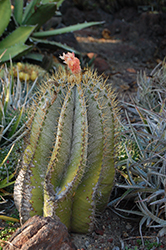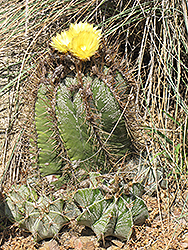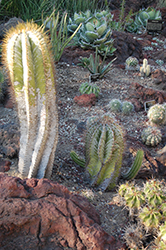It's all about ...
plants

Height: 6 feet
Spread: 12 inches
Sunlight:
![]()
Hardiness Zone: 9b
Other Names: Bishop's Cap Cactus; Star Plant, Echinocactus
Description:
This cactus is solitary and cylindrical in form, potentially growing quite tall; it develops white, woolly flakes for sun protection; canary yellow flowers appear throughout the summer when plant matures; a wonderful addition to the rock garden
Ornamental Features
Monk's Hood Cactus is a member of the cactus family, which are grown primarily for their characteristic shapes, their interesting features and textures, and their high tolerance for hot, dry growing environments. Like all cacti, it doesn't actually have leaves, but rather modified succulent stems that comprise the bulk of the plant, and which are designed to hold water for long periods of time. This particular cactus is valued for its rigidly upright and cylindrical habit of growth, and usually grows as a single spiny ribbed green stem. This plant has yellow cup-shaped flowers with gold eyes held atop the stems from early to late summer, which are interesting on close inspection.
Landscape Attributes
Monk's Hood Cactus is a succulent evergreen plant with a strongly upright, cylindrical form. It tends to grow as a solitary entity comprised of a single stem, and it doesn't usually spread laterally. As a type of cactus, it has no true foliage; the body of the plant is wholly comprised of a spiny green stem which is prominently ribbed.
This is a relatively low maintenance plant, and should never be pruned except to remove any dieback, as it tends not to take pruning well. Deer don't particularly care for this plant and will usually leave it alone in favor of tastier treats. Gardeners should be aware of the following characteristic(s) that may warrant special consideration;
- Spiny
Monk's Hood Cactus is recommended for the following landscape applications;
- Accent
- Rock/Alpine Gardens
- General Garden Use
- Container Planting
Planting & Growing
Monk's Hood Cactus will grow to be about 6 feet tall at maturity, with a spread of 12 inches. It is often grown as either a solitary specimen or in combination with other complementary plants as part of a garden composition. It grows at a slow rate, and under ideal conditions can be expected to live for 60 years or more.
This plant should only be grown in full sunlight. It prefers dry to average moisture levels with very well-drained soil, and will often die in standing water. It is considered to be drought-tolerant, and thus makes an ideal choice for a low-water garden or xeriscape application. Like most succulents and cacti, this plant prefers to grow in poor soils and should therefore never be fertilized. It is not particular as to soil pH, but grows best in sandy soils. It is highly tolerant of urban pollution and will even thrive in inner city environments. This species is not originally from North America..
Monk's Hood Cactus is a fine choice for the garden, but it is also a good selection for planting in outdoor pots and containers. Because of its height, it is often used as a 'thriller' in the 'spiller-thriller-filler' container combination; plant it near the center of the pot, surrounded by smaller plants and those that spill over the edges. Note that when growing plants in outdoor containers and baskets, they may require more frequent waterings than they would in the yard or garden. Be aware that in our climate, most plants cannot be expected to survive the winter if left in containers outdoors, and this plant is no exception. Contact our experts for more information on how to protect it over the winter months.
This plant is not reliably hardy in our region, and certain restrictions may apply; contact the store for more information.


